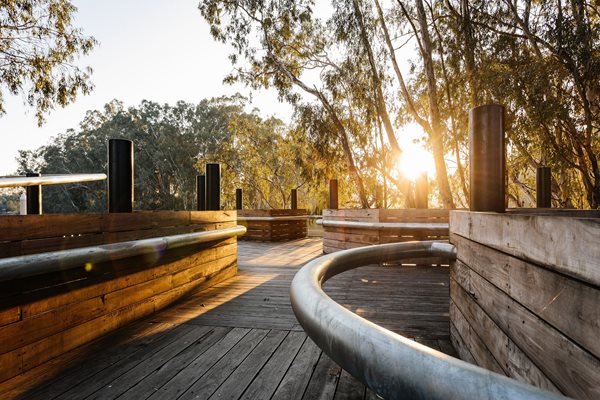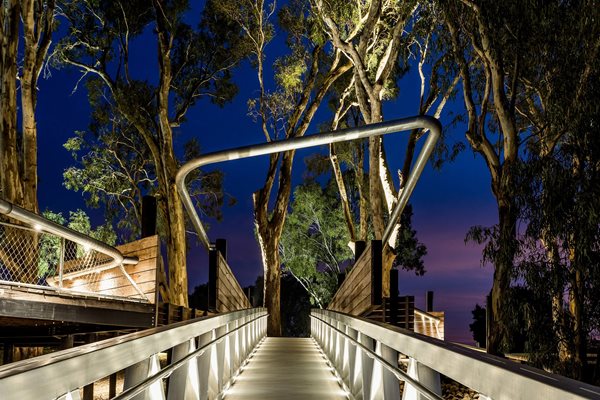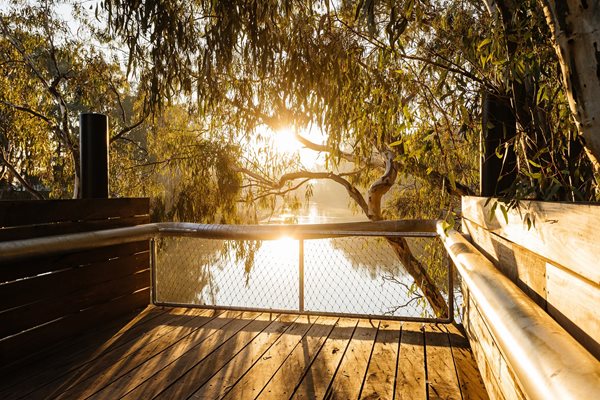
From the architect:
Koondrook is a small regional town (population 900) located at the midpoint of the Murray River that was a vital trading point for riverboats until the removal of the town’s wharf more than fifty years ago, when the town lost its connection to the river.
The brief called for a reinstatement of the original wharf. Our response questioned what a wharf would deliver, and why the community and local government would reinstate the original. The highly contested State and Federal regional funding contributed to this project necessitated an approach to “do it right and do it once”.
Our design maintains some historical components while providing mooring for recreational boat users, larger paddle steamers and house boats. This resonated strongly with the community and Council who had a shared interest in discovering the potential to unlock enhanced benefit for this quaint regional town.
Koondrook Wharf is more than just a wharf; it is a place to experience and reconnects the town to the river. It not only provides a greater connection between the township and the river but also exemplifies the unique location and showcases the local history.

Koondrook Wharf comprises five identifiable components:
Turntable: Artwork by renowned local Aboriginal artists Glenn Romanis and Esther Kirby depicts the location of Koondrook and nearby towns, tells the story of the original Aboriginal inhabitants along the river and marks the position of the original railway turntable. A timber inlay the width of the Victorian rail broad gauge, references the original railway siding on site and is on axis with the town’s main street. Riverside of the turntable there is a 10m-wide timber deck, flush with the ground, which connects to the wharf structure and provides space for a temporary large marquee for special events.
Viewing platforms: Made of the native Red Gum timber, the platforms ‘weave’ through the existing Red Gum trees and minimise the loss of vegetation. The four platforms frame desirable views; the first back over the site of the original wharf towards the adjacent heritage-listed goods shed reinterprets the approach of paddle steamers once ‘rounding up’ to the old wharf. The second upriver and the third downriver. The fourth to the nearby sawmill, where the sound of milling timber is part of the town’s industrial heritage.

The timber decking on the platforms is all laid lengthways to appear to be ‘coming in’ from the river, making reference to how logs used to be transported from paddle steamers to the nearby sawmill. The timber viewing platforms are tied together by a large-diameter galvanised steel handrail that emerges from the ground, subtly assists in framing the views and returns on the opposite side of Koondrook Wharf into the river bank.
Gangway and pontoon: The single span 28m long gangway and floating pontoon allow river vessels to dock year-round at all river levels. The wharf contends with an annual river level fluctuation of over 5m vertical height.
Terraced steps: Concrete aggregate steps reference the dry riverbed aesthetic and connect the wharf to the riverbed. They provide a space for play and enjoyment for users wanting to engage with the water’s edge.
The timber decking and structure was supplied by Arbuthnot Sawmills, a local family company established in 1889. The Red Gum used on Koondrook Wharf is from a sustainably managed and renewable resource - harvested within 4km of the town, then milled and air dried at the sawmill only 200m from the wharf.

